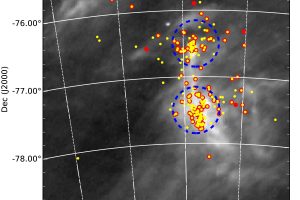“The Gaia-ESO Survey: Structural and dynamical properties of the young cluster Chamaeleon I” by G. Sacco published on Astronomy & Astrophysics

The star formation process starts with the gravitational collapse of large and cold clouds of gas and dust. Despite it sounds like a simple process, it is actually very complicated and we still lack full comprehension of the details of how these clouds can form clusters and associations of young stars.
This is one of the main objectives of the Gaia-ESO Survey (GES), project in which the Astronomical Observatory of Palermo is strongly involved, which is the most extended survey of stellar clusters to date. GES has been described in more details in the research highlights of March 2017. Thanks to spectroscopic observations at high resolution with ESO instruments, GES allows to identify stars associated with more than 50 stellar clusters, and to study their physical and dynamical properties. In this way it will be possible to understand how the final product of the star formation process is related to the initial star forming environment.
This is the main objective of the paper “The Gaia-ESO Survey: Structural and dynamical properties of the young cluster Chamaeleon I“, the most recent paper based on GES data, which has been published in Astronomy & Astrophysics by G. Sacco, astronomer of the Astrophysical Observatory of Arcetri. The GES team of the Astronomical Observatory of Palermo ( , , ) is among the coauthors of the paper.
In this paper the morphology and dynamic of the stellar cluster Chamaeleon I is studied with GES data. The main results of the paper are: the selection of two subclusters in the north and south regions with a velocity shift of about 1 km/sec; the evidence that the cluster velocity dispersion is significantly larger than that of the prestellar cores (1.14 vs. 0.3 km/sec), likely due to interactions between the local magnetic field and the prestellar cores of the collapsing filaments or to two-body gravitational interaction between the forming stars of the cluster; and the evidence that the cluster has formed in a low density and highly structured environment.
In the figure (link), Far infrared (140 μm) map of the region around the young cluster Cha I from the AKARI all-sky survey (Doi et al. 2015). Yellow dots indicate the positions of all the known members from the literature, while the bigger red dots indicate the positions of all the members selected by the GES observations according to the criteria discussed in Sacco et al. (2017). The dashed blue circles (centers RA1 = 167.2°, Dec1 = –76.5°, RA2 = 167.2°, Dec2 = –77.5°, and radius 0.35°) delimit the north and south subclusters
